Introduction
Osteoporosis results from reduced bone mass and disruption of the micro-architecture of bone, giving decreased bone strength and increased risk of fracture, particularly of the spine, hip, wrist, humerus, and pelvis. The risk of fractures increases steeply with age and most of those affected are over 75. Osteoporosis occurs when there is an imbalance between new bone formation and old bone resorption. The body may fail to form enough new bone, or too much old bone may be reabsorbed, or both. The leading cause of osteoporosis is a lack of certain hormones, particularly estrogen in women and androgen in men. Women, especially those older than 60 years of age, are frequently diagnosed with the disease. Other factors that may contribute to bone loss in this age group include inadequate intake of calcium and vitamin D, lack of weight-bearing exercise, and other age-related changes in endocrine functions.
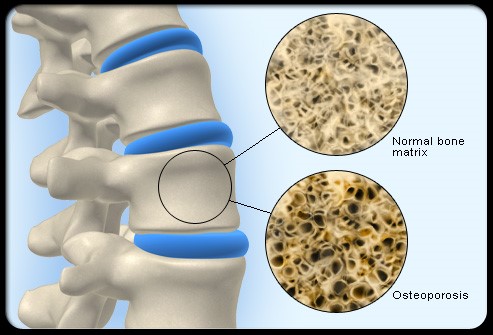 |
| Source : www.medicinenet.com |
Exercise and bone strength
Bone is a scaffold that supports the body against the forces of gravity and resists the pull of the muscles to allow movement. These loads and forces ensure that the skeleton remains able to resist the everyday burdens imposed upon it. Bone is a living tissue that reacts to increases in loads and forces by growing stronger. It does this all the time, so exercise will only increase bone strength if it increases the loading above normal levels. Younger, active people produce more new bone tissue than they lose, and therefore their bone density increases. Generally we achieve maximum bone density and strength (peak bone mass) around the age of 30. Bone density gradually begins to decline as we age, and most of us also become less active. For women, bone loss is usually most rapid during the first few years after menopause. Exercise, healthy eating and other lifestyle changes can slow the bone loss that usually occurs as we age and may help to reduce the risk of our bones breaking.
We all need exercise to help our bone health. Exercises for good bone health aim to :-
(a) Strengthen bones,
(b) Strengthen muscles
(c) Maintain good balance and posture.
Exercises that are good for bones and muscles are those activities that are weight bearing. This is because these activities stress the bone and promote them to react by getting stronger. These weight bearing exercises can be graded into low, moderate and high impact.
Weight-bearing exercise: any exercise in which you are supporting your own body weight through your feet and legs (or hands and arms).
1. Low Impact Exercises
Examples are brisk walking, low impact aerobics, stair climbing.
2. Moderate Impact Exercises
Power walking (brisk walking with vigorous arm movements and/or use of hand weights. You should aim to do a minimum of 30 minutes daily of low or moderate impact activity. You can split the time up into 10 minute portions if it helps.
3. High impact Exercises
High impact aerobics, skipping, jumping exercises, jogging, running. For example hopping up and down, about five inches off the floor, and landing flat footed, at least 15 times, daily.
If you do NOT have osteoporosis you should do some high impact exercise.
If you have osteoporosis or have fractured a bone in the past, you should avoid high impact exercise, bending activities such as sit ups and other forms of exercise that are not weight bearing, such as cycling and swimming, do not directly strengthen bones, but can be very useful in strengthening the muscles and helping with flexibility.
Weight training exercises, involving lifting light free weights help to strengthen bones and muscles and should be performed at least three times per week. You should get some instruction from a physiotherapist before embarking on routine exercise.
Some basic postural, strengthening and stretching exercises are given below :-
1. Postural Exercise
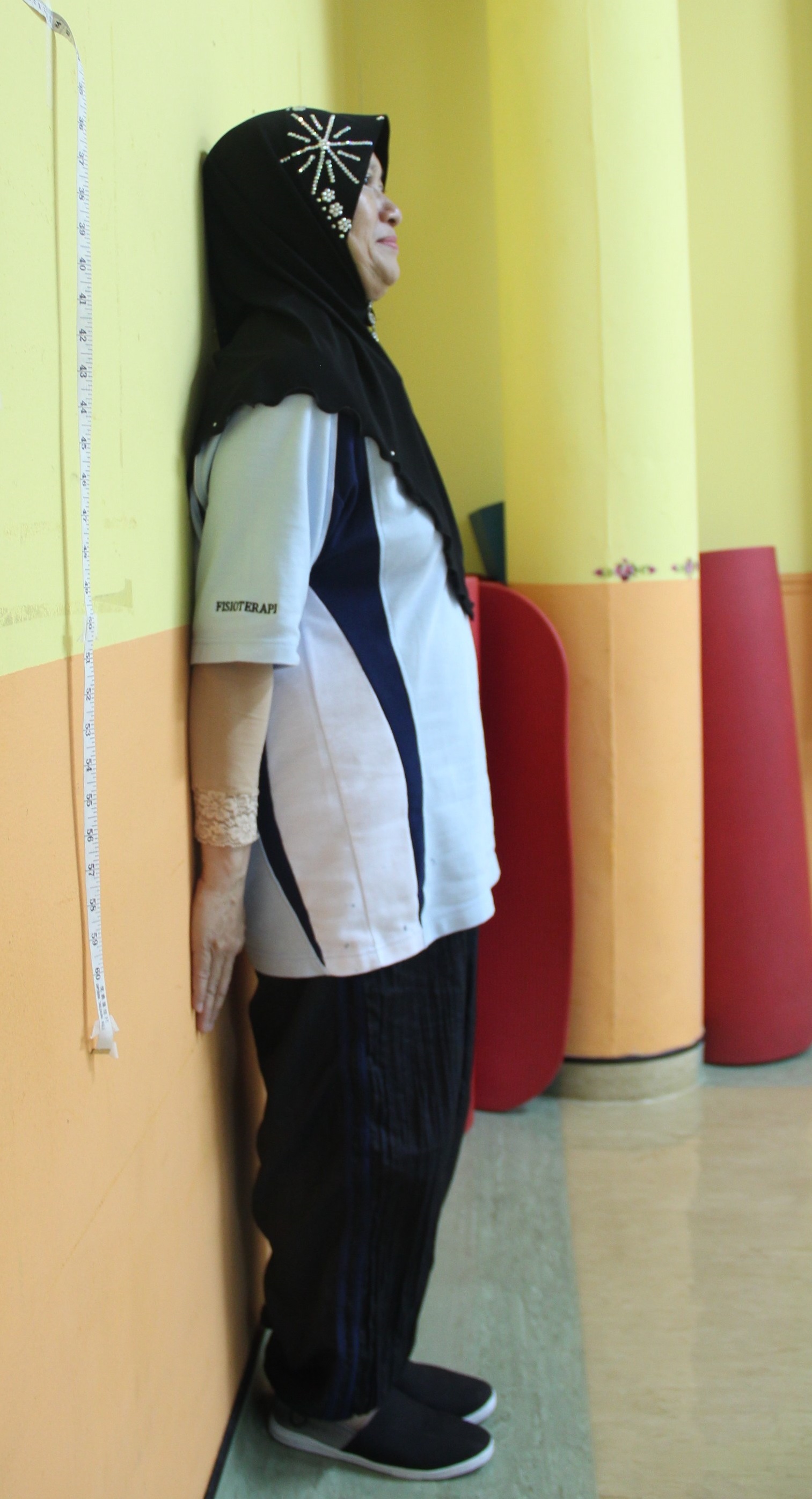 |
| Stand with your head, shoulders and buttocks against a wall, with your heels 2 to 3 inches from the wall. Relax your shoulders and pull in your chin. Tighten your abdomen and buttocks. Press your back against the wall, leaving room for your hand to flat behind the curve of your lower back. Hold 30 seconds. |
2. Wall arch
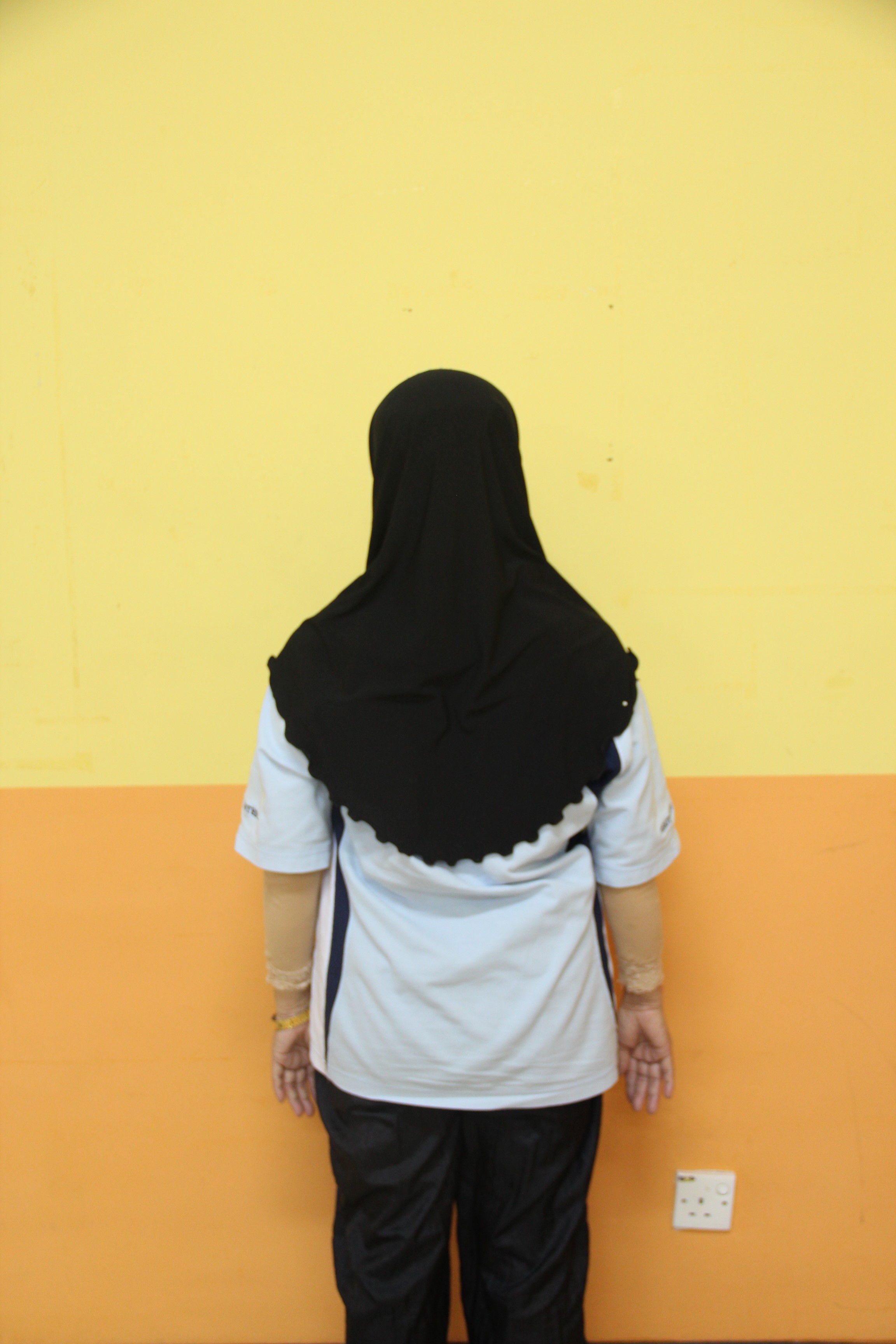 |
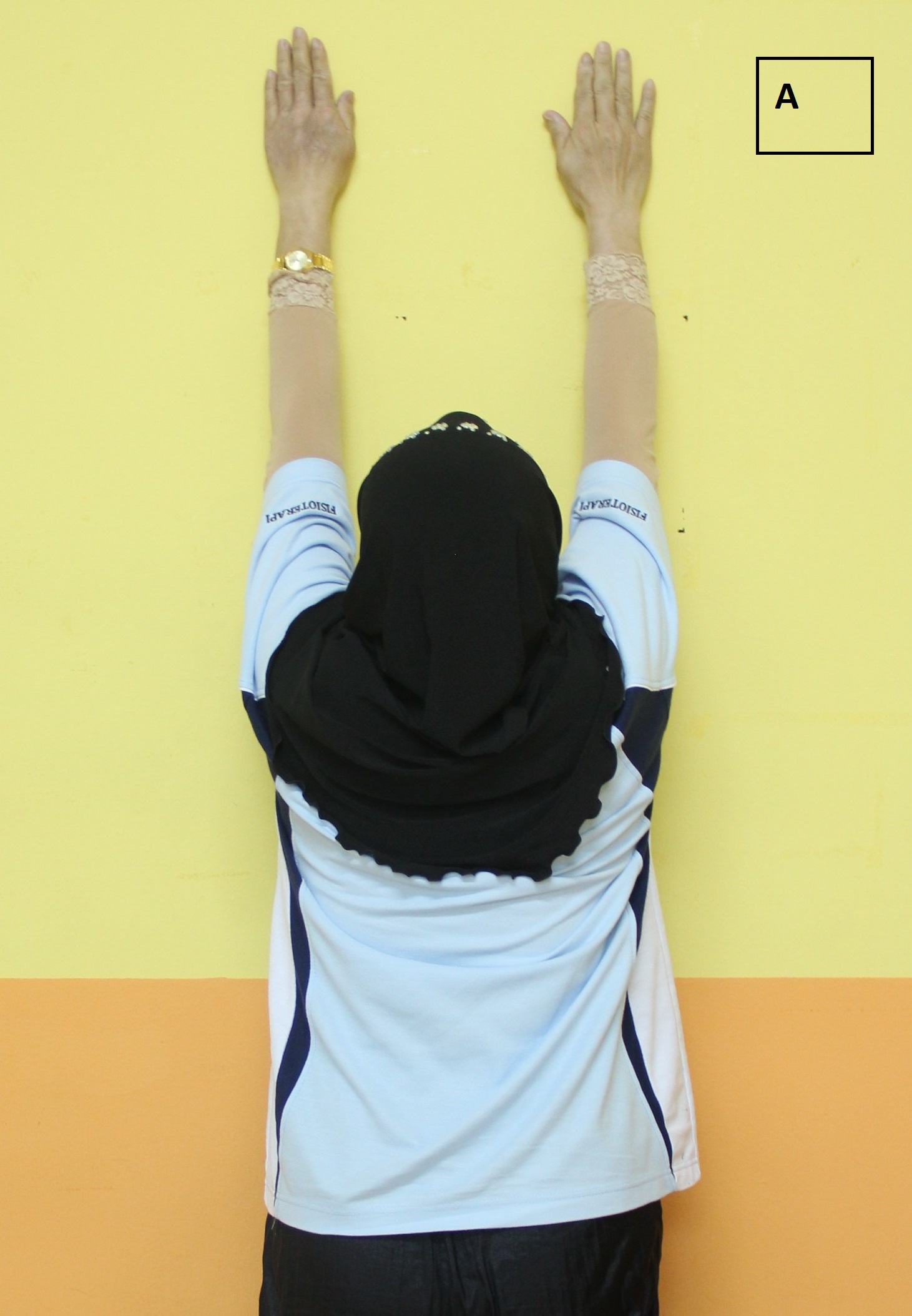 |
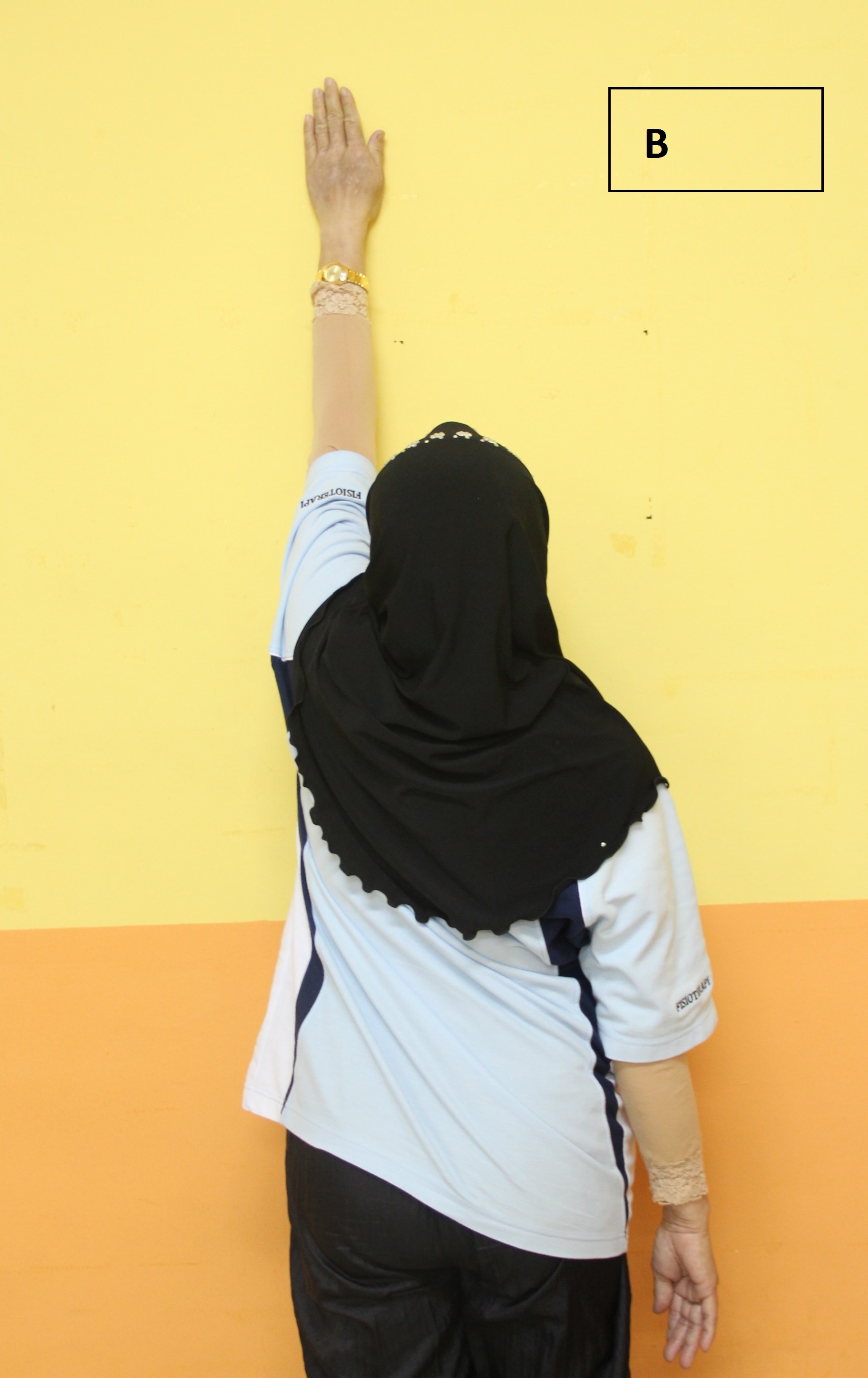 |
|
Stand facing the wall, arms at your sides, feet 6 inches apart and 6 inches from the wall: a) Stretch both arms up to touch the wall and lower both of your arms to the starting position. b) Reach up with your left arm and stretch down with your right arm. Lower your left arm to the starting position. Switch arms and repeat. 5 times each arm. c) Do not look up. Look in front. |
3. Wall slide
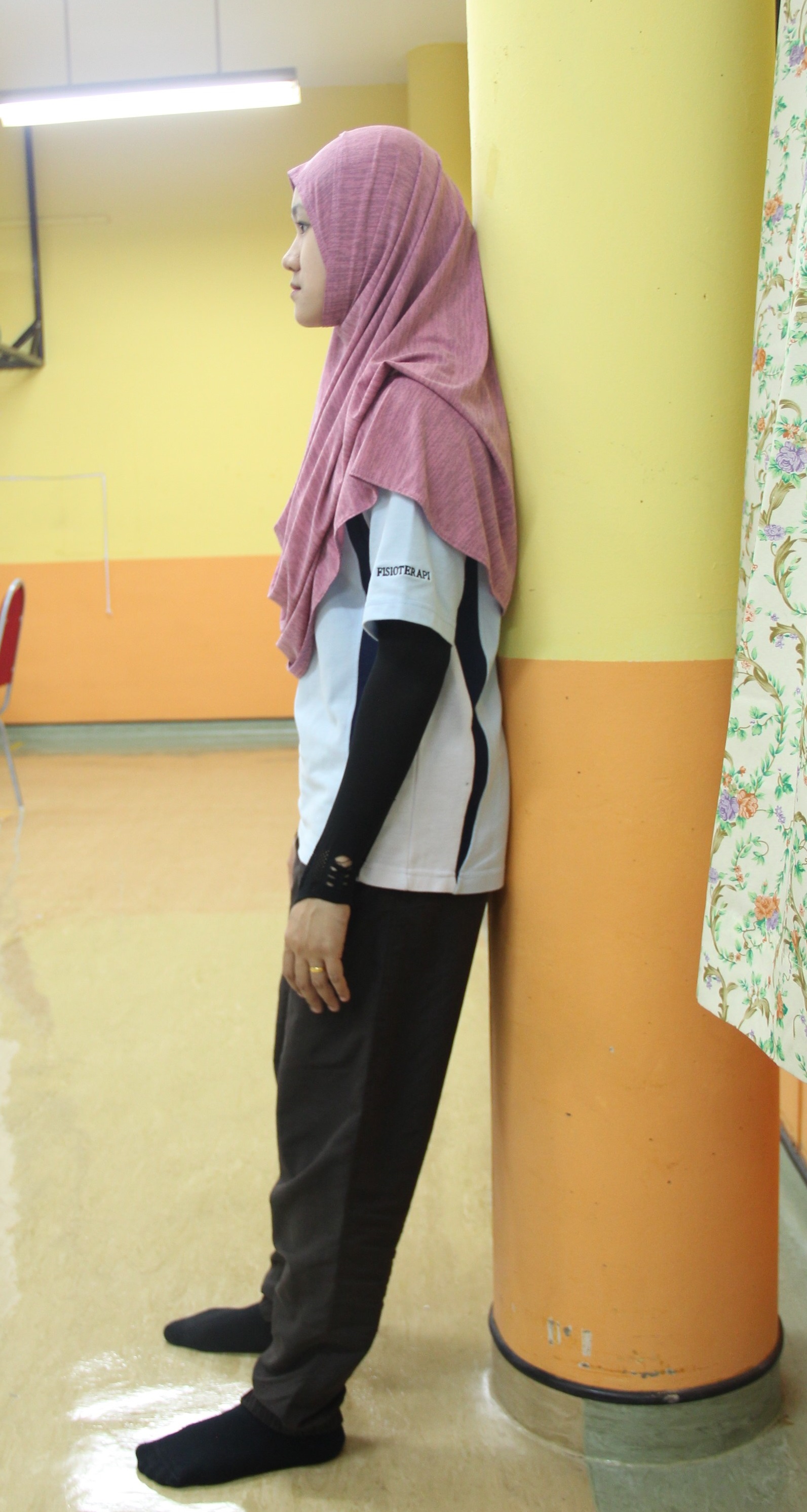 |
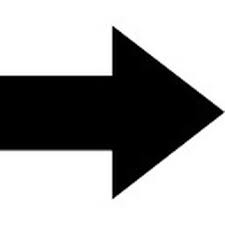 |
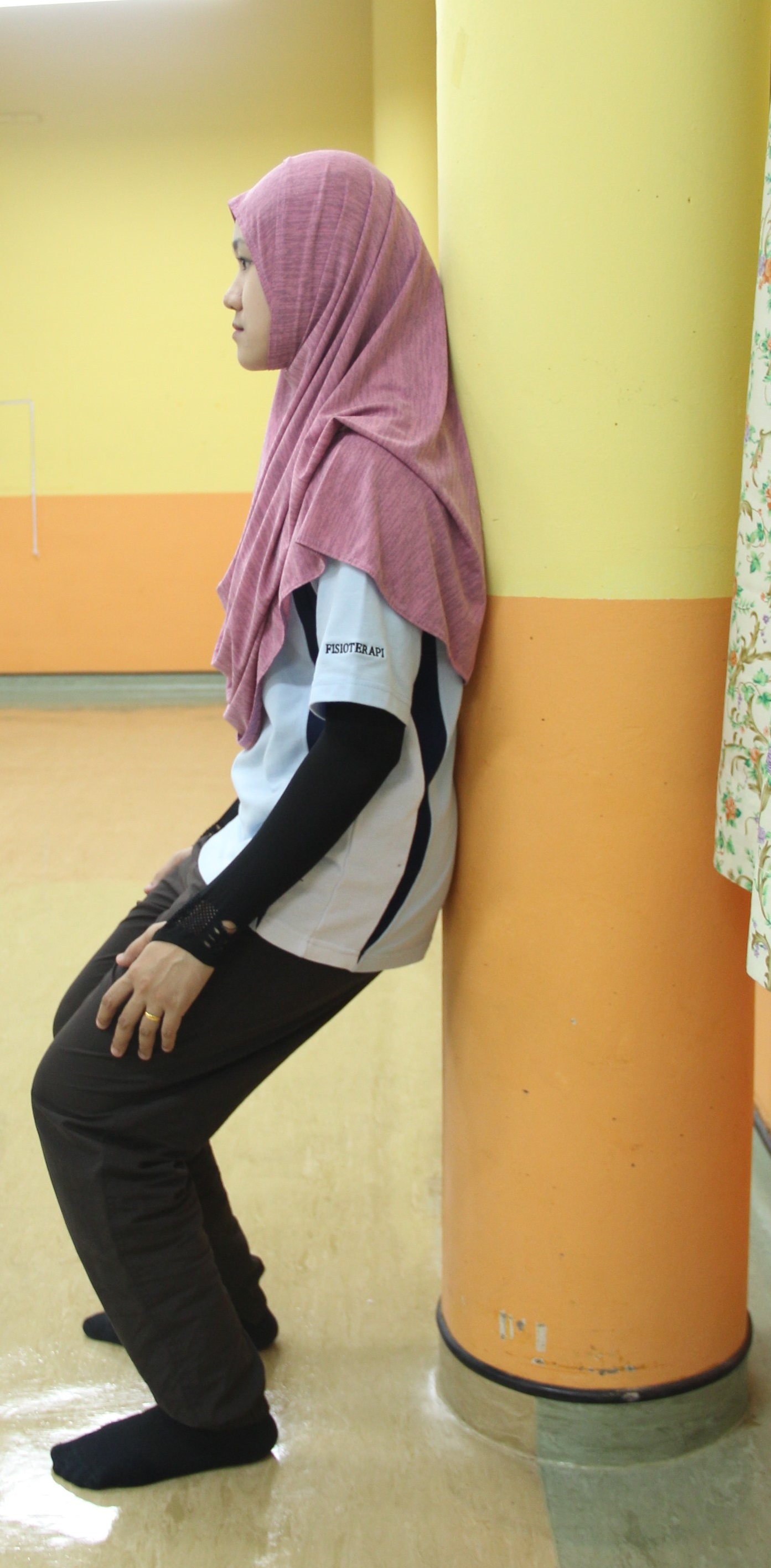 |
| Stand with your heels one shoe-length from the wall. Keep your feet straight ahead and shoulder width apart. Place your buttocks and shoulders against the wall. Tuck your chin in so that the back of your head is as close to the wall as possible. Slide up and down, bending your knees half-way to a sitting position. Keep your shoulders back and abdomen flat. Keep your back flat. Repeat 10 times. |
4. Knee Bend (Flexion)
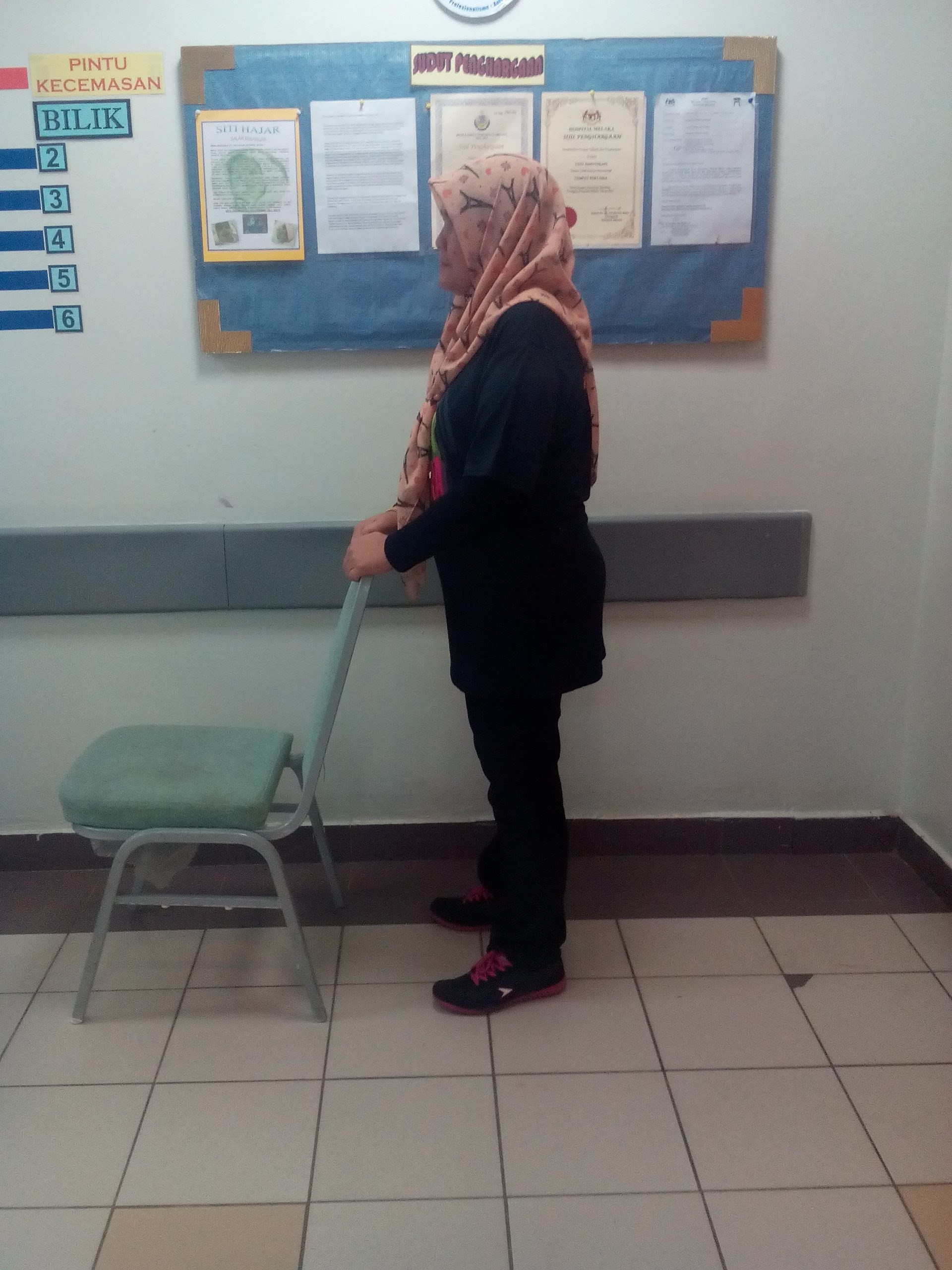 |
 |
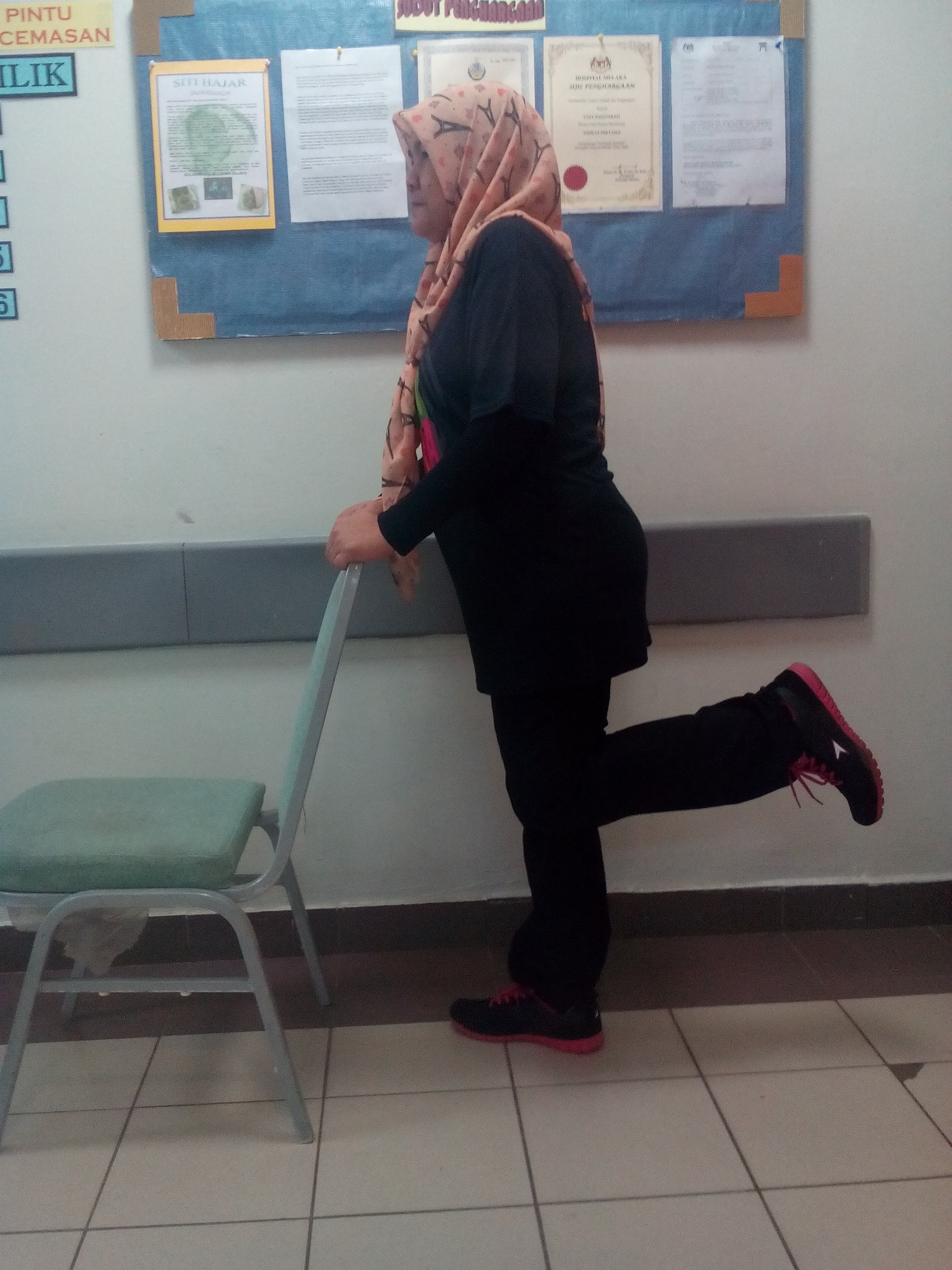 |
|
Stand straight, hold onto chair for balance. Slowly bend knee as far as possible. Hold position 20 second. Slowly lower foot all the way back down. Repeat 10 times each leg |
5. Ankle joint – Toe raises/ heel raises
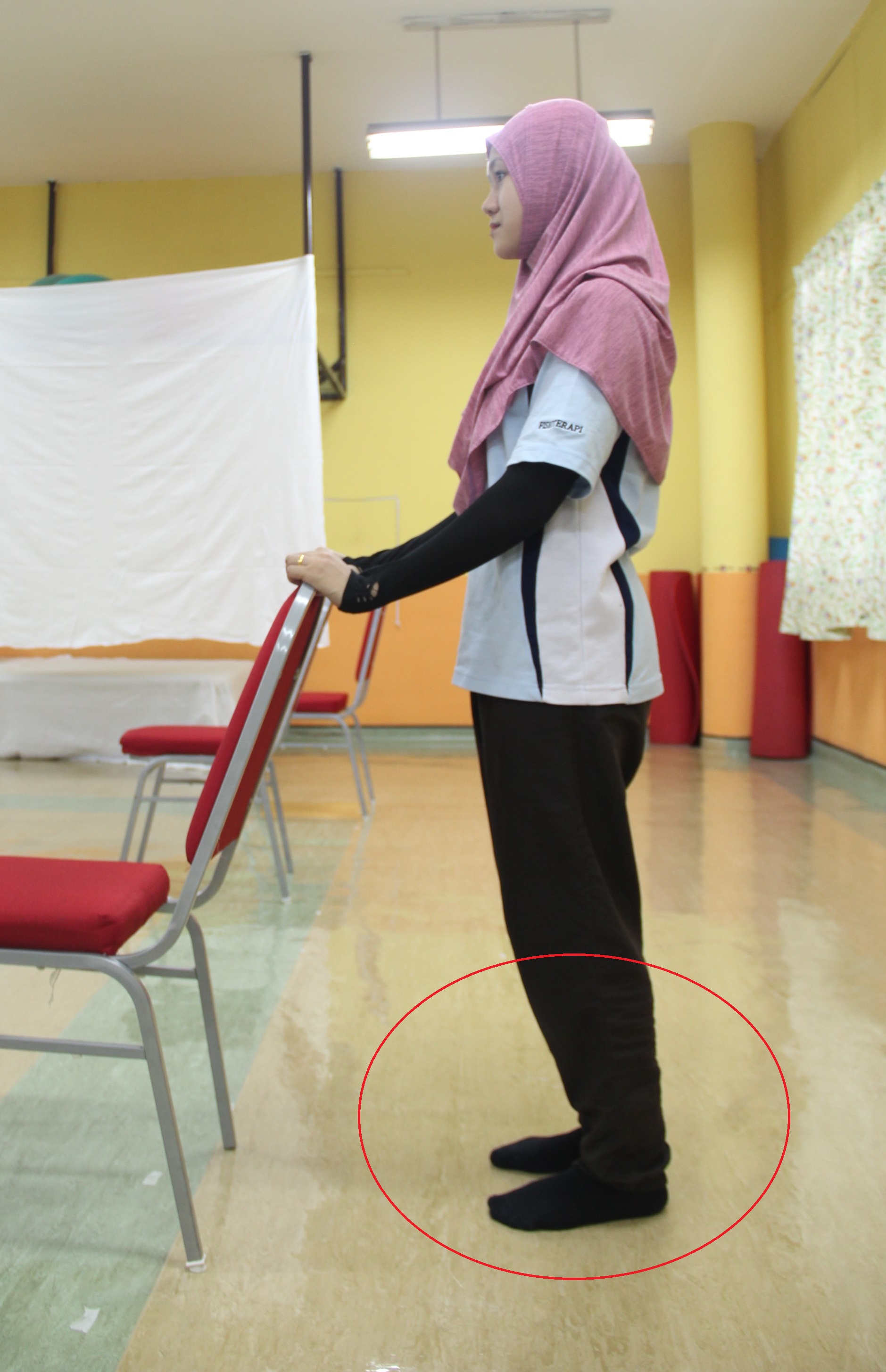 |
 |
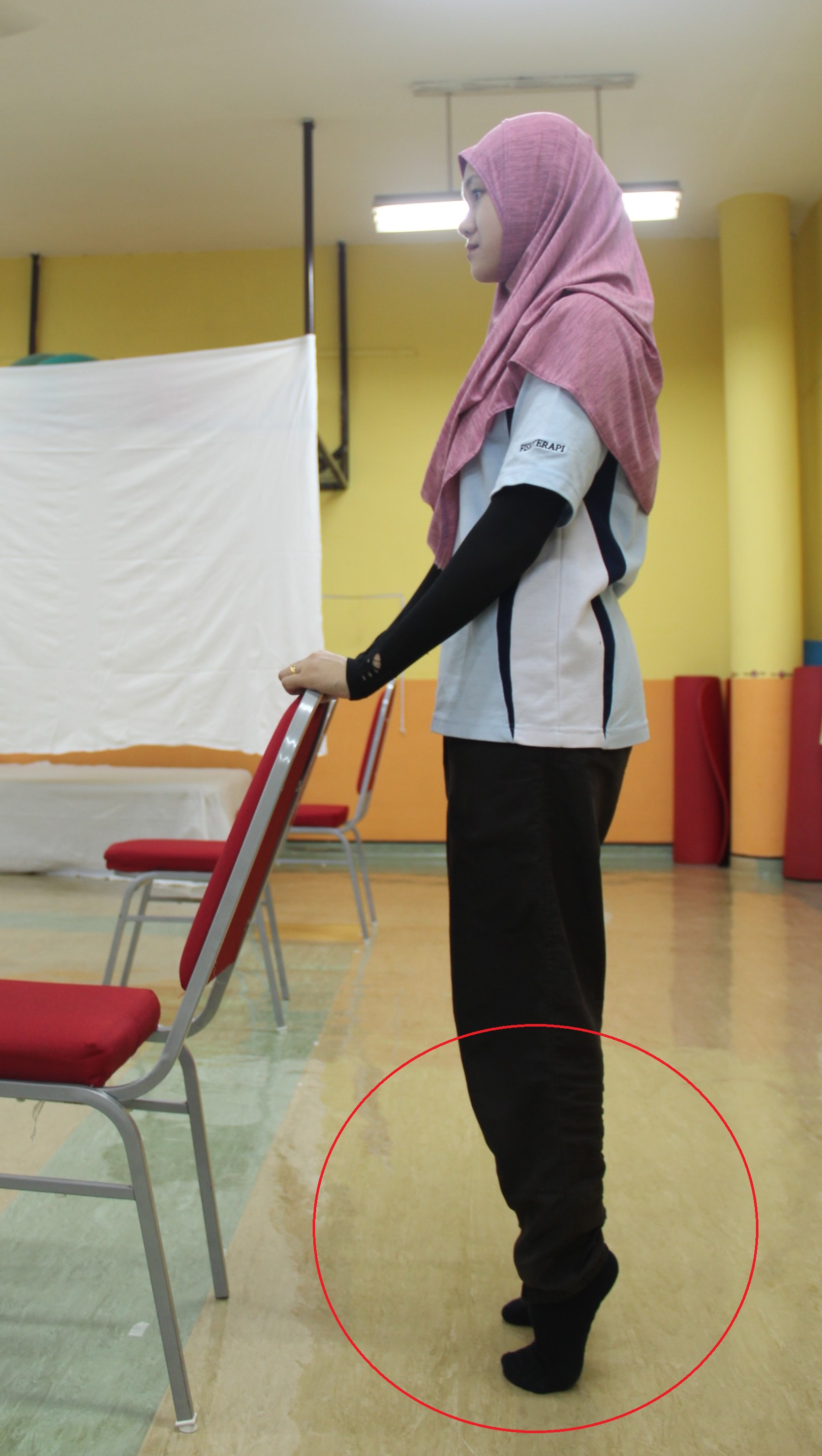 |
 |
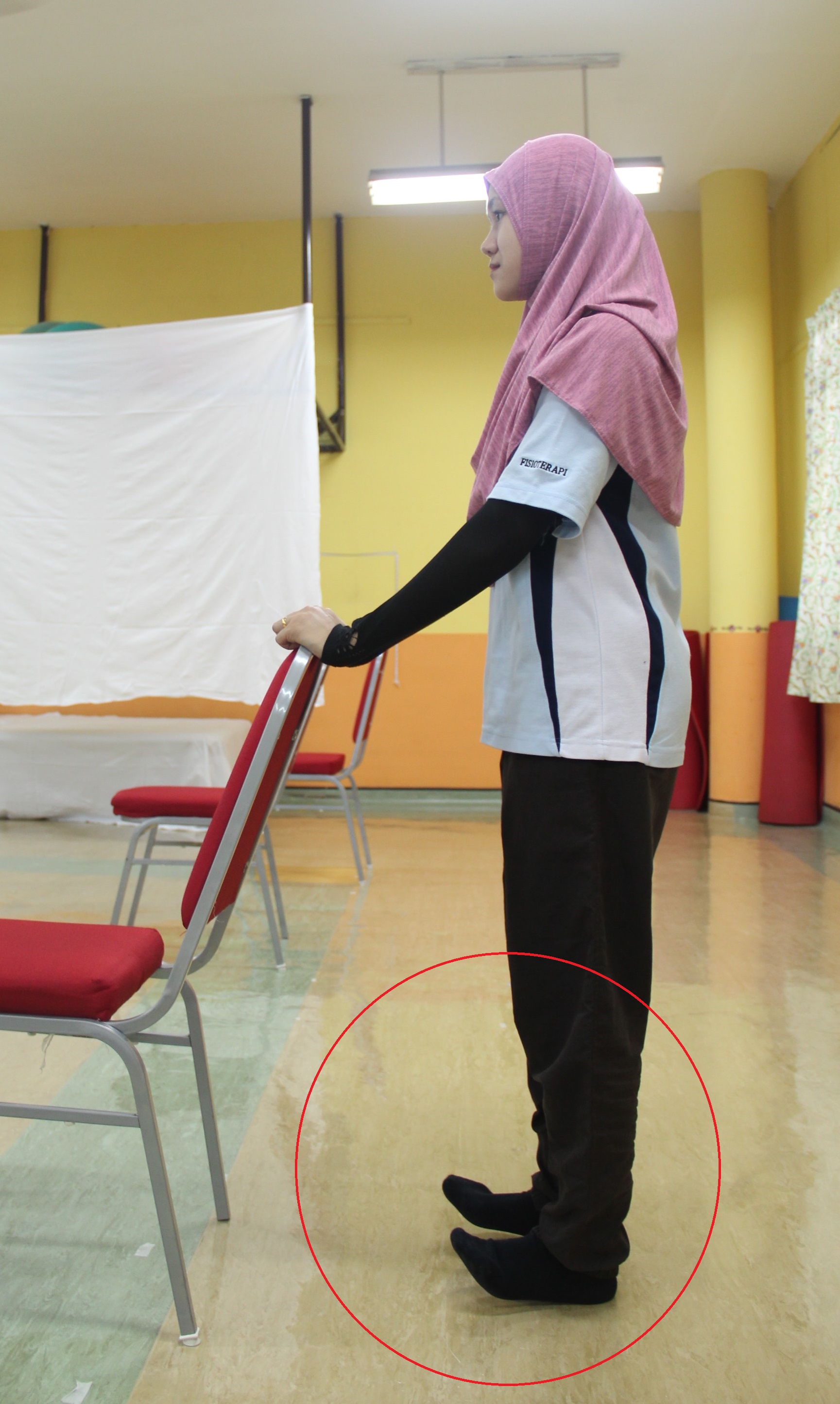 |
|
Stand straight and hold onto the back of a chair, without bending at the waist or knees. Rise up on your toes and then back onto your heels. When you rise up onto your toes, imagine you are moving your head up to the ceiling. Repeat 10 times. Hold on to the chair as little as possible to challenge your balance. Do this twice each day. |
6. Bicep curl
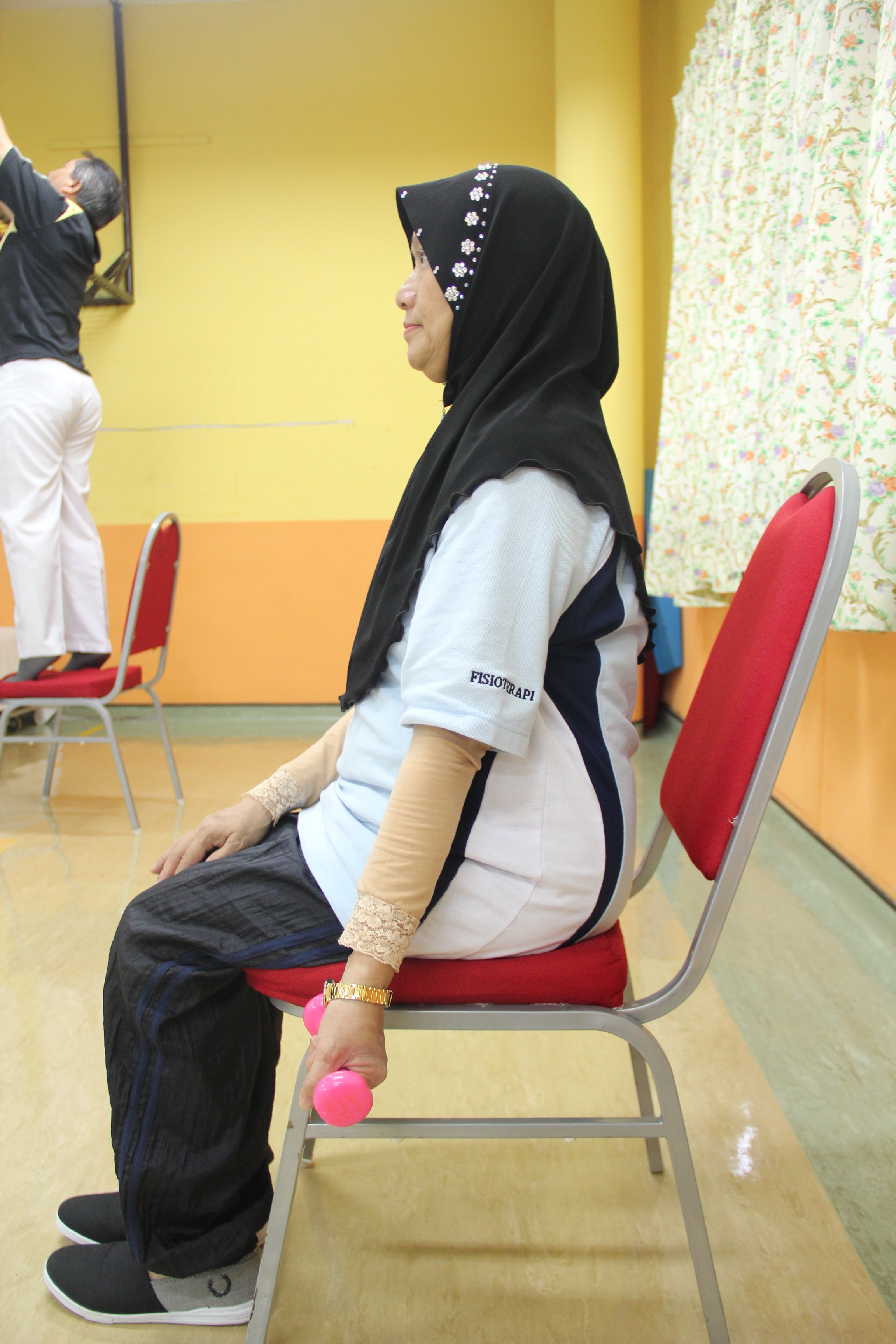 |
 |
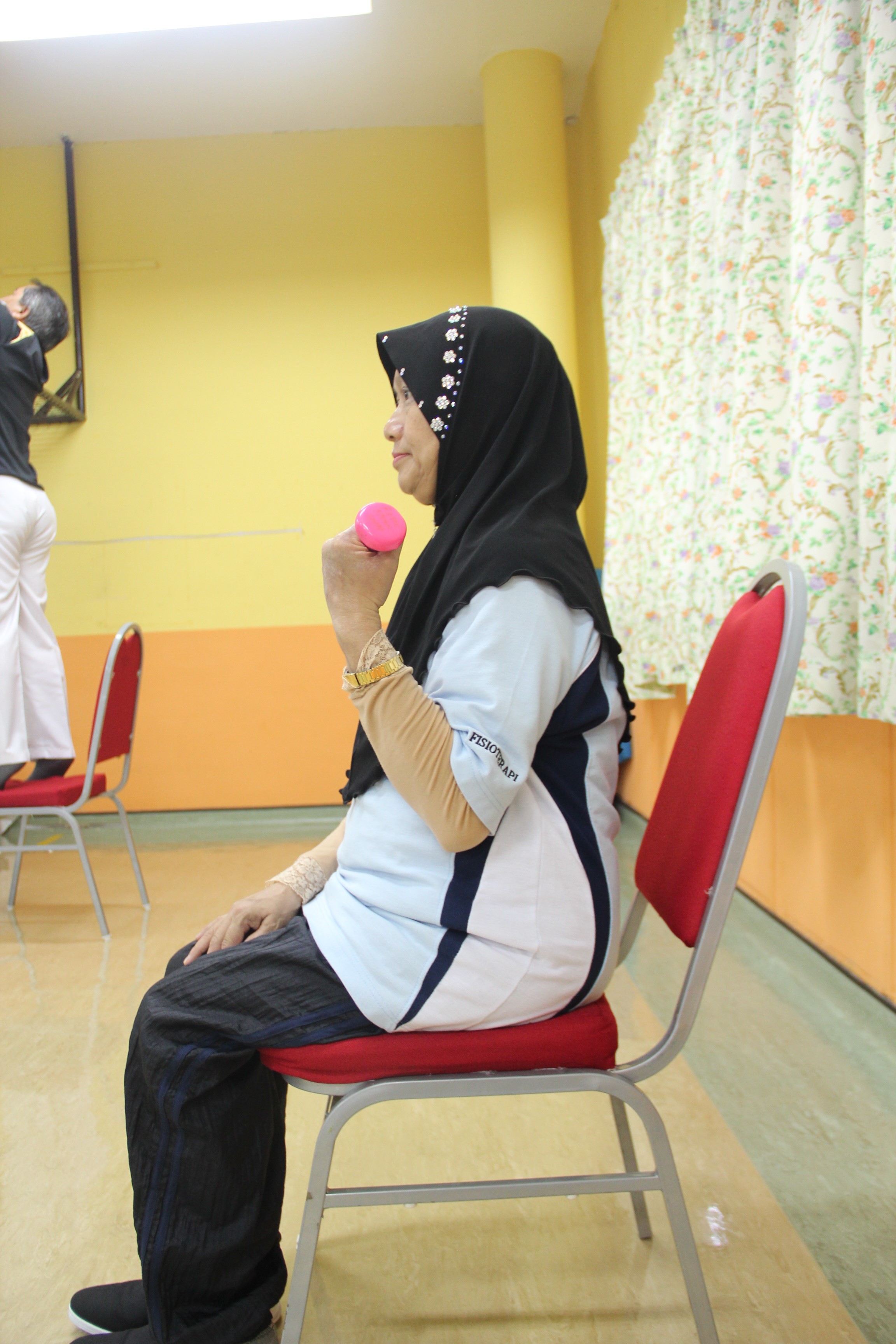 |
|
Sit straight in arm less chair. Feet flat on floor; keep feet even with shoulders. Hold hand weights at sides, arms straight, palms in. Slowly bend one elbow, lifting weight toward chest. (Rotate palm to face shoulder while lifting weight.) Hold position for 10 second. Slowly lower arm to starting position. Repeat 10 times each arm. |
7. Chest stretch
 |
 |
 |
| Sit with your feet flat on the floor. Keep your back erect and look straight ahead. Bend your arms at the elbows and bring your hands toward your chest (1). Stretch your arms out to the side, keeping them level with your shoulders (2). Repeat 10 times. |
8. Back Posture exercise
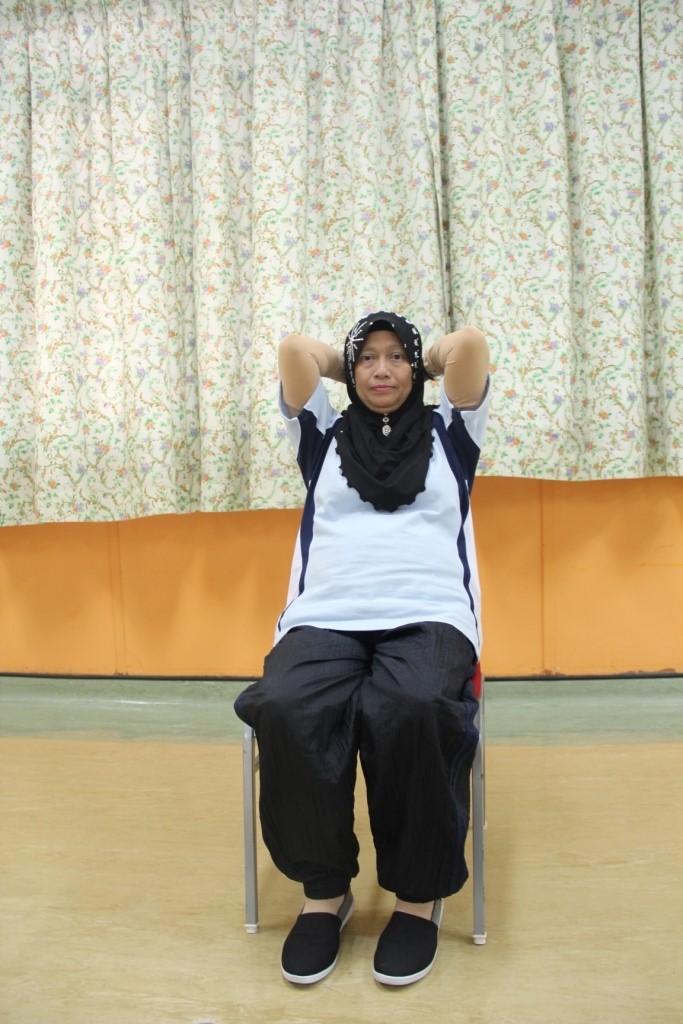 |
 |
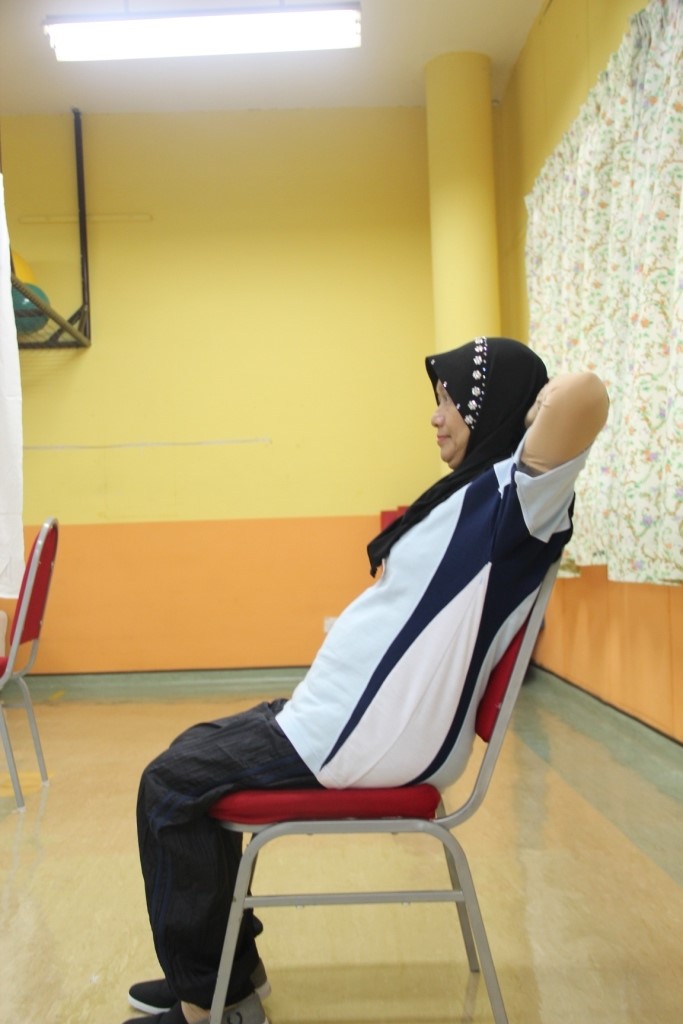 |
| Sit in a chair as shown, with your hand behind your neck (1). Gently moving your elbows backward (2). Hold the position for 10 second, before returning to your starting position. Repeat 10 times. |
9. Sitting knee straight ( extension)
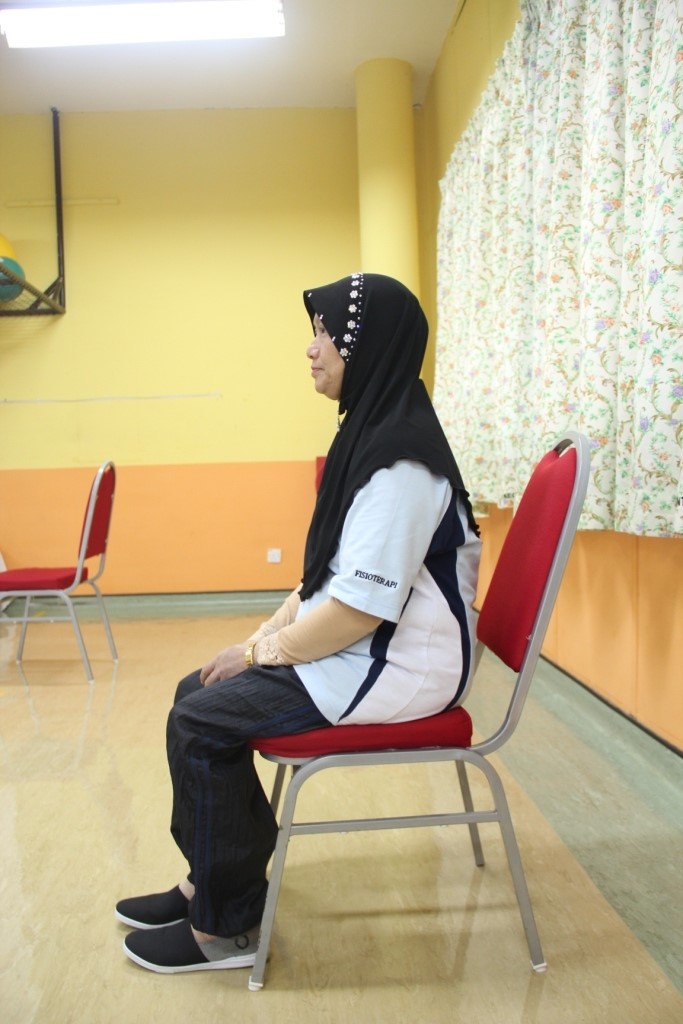 |
 |
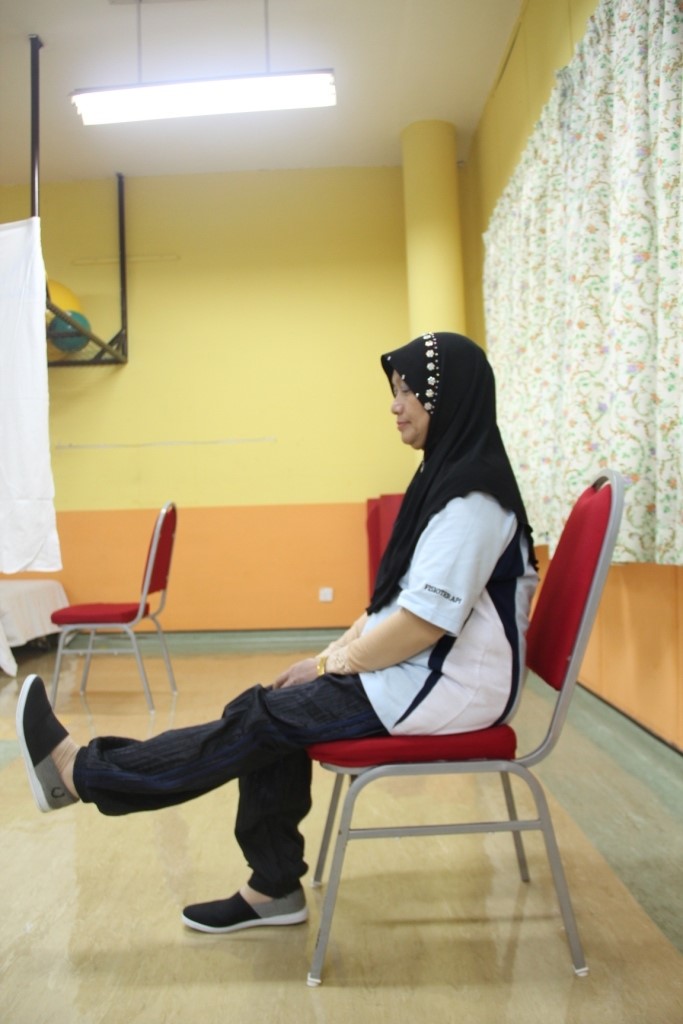 |
| Sit in chair. Put rolled towel under knees, if needed. Slowly extend one leg as straight as possible. Hold position and flex foot to point toes toward head for 10 second. Slowly lower leg back down. Repeat 10 times each leg. |
10. Arm rise
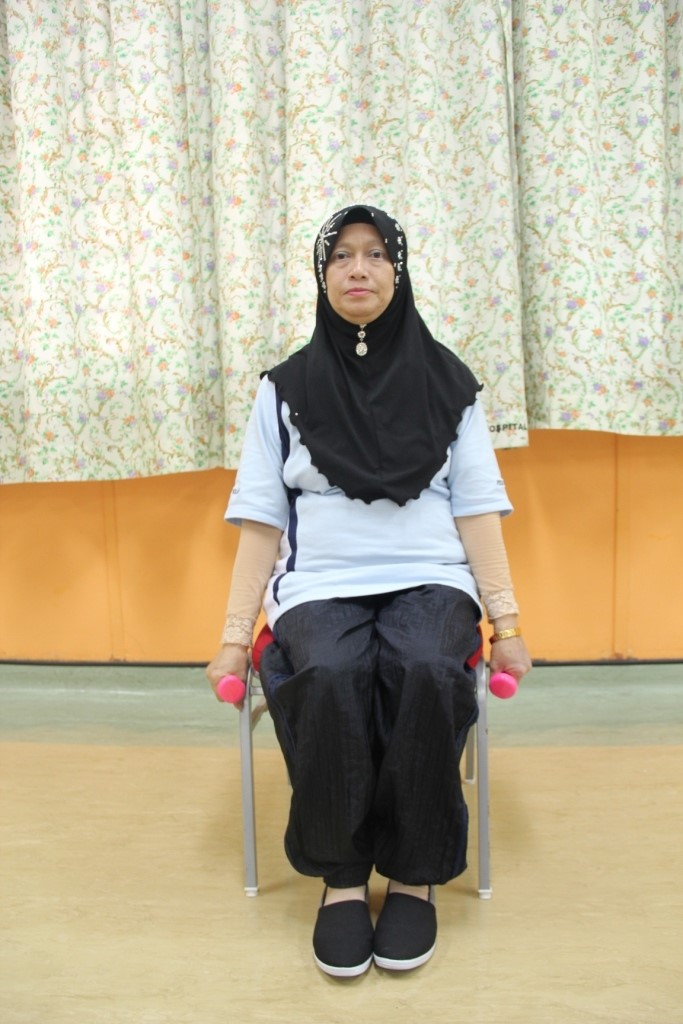 |
 |
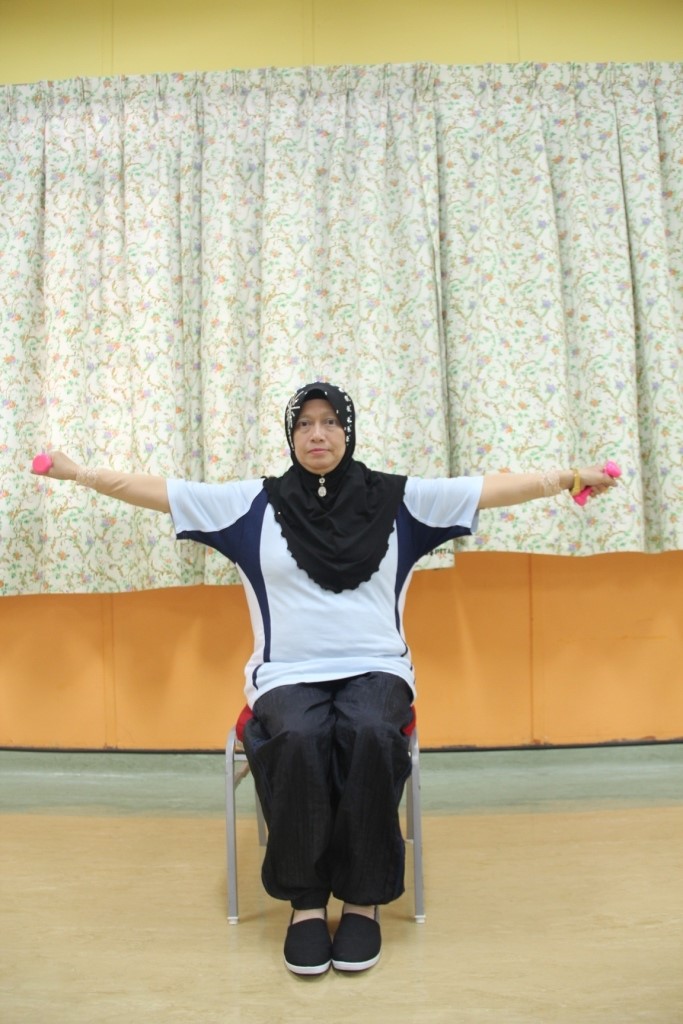 |
|
Sit in chair. Feet flat on floor; keep feet even with shoulders. Hold hand weights straight down at sides, palms inward. Raise both arms to side, shoulder height. Hold position for 5 second. Slowly lower arms to sides. Repeat 10 times. |
11. Abdominal exercise
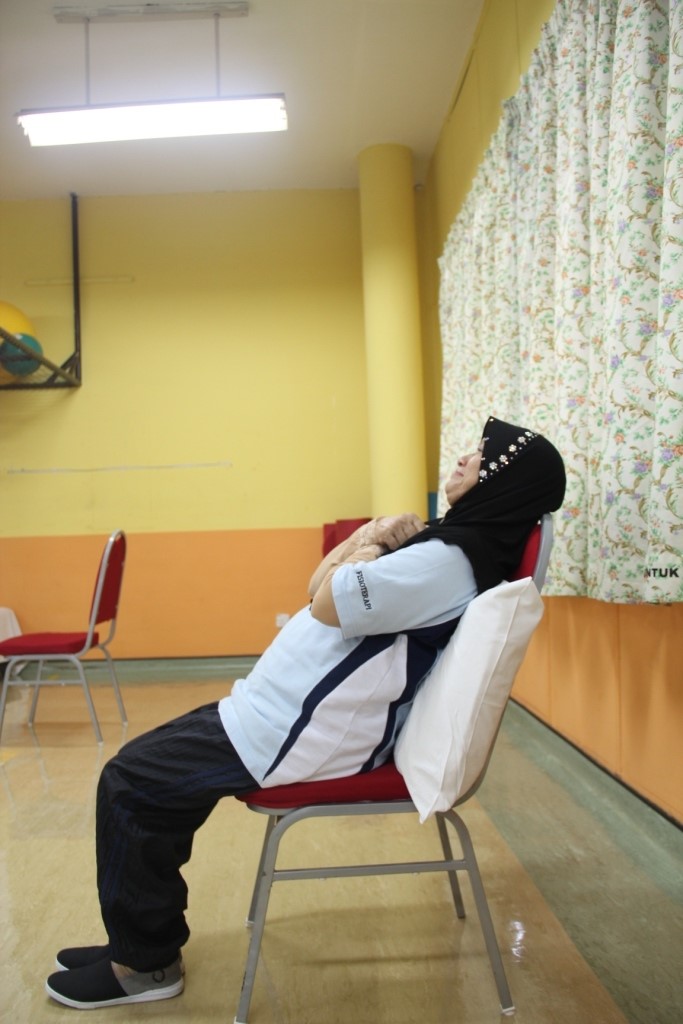 |
 |
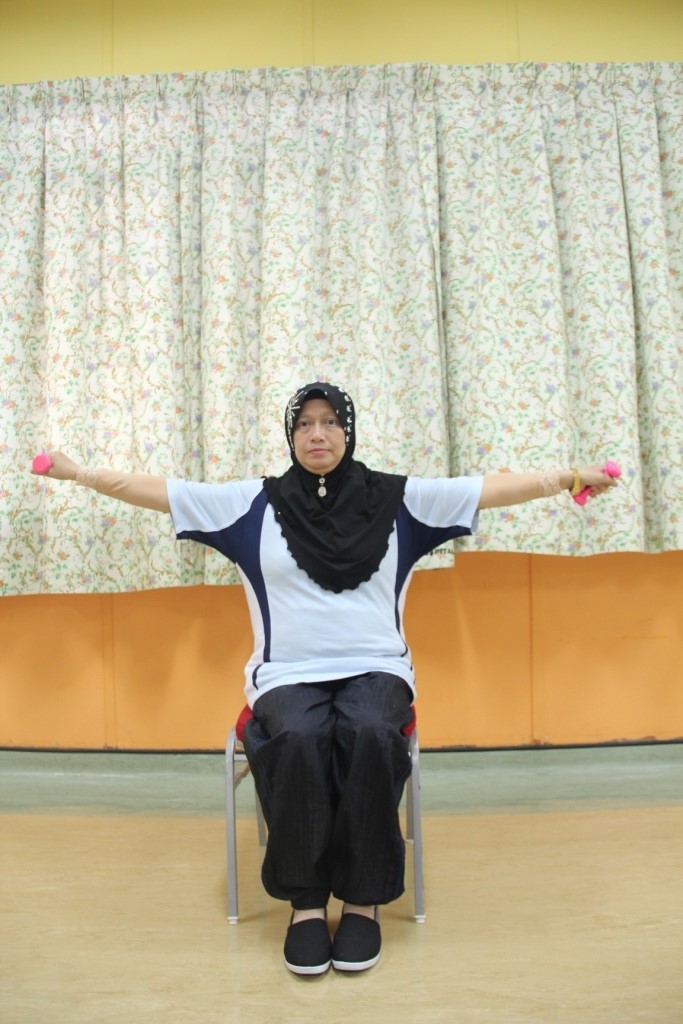 |
|
Place pillows against back of chair. Sit in middle or toward front of chair, knees bent, feet flat on floor. Lean back on pillows, in half-reclining position, back and shoulders straight. Raise upper body forward until sitting upright, using hands as little as possible. Slowly stand up, using hands as little as possible. Slowly sit back down. Keep back and shoulders straight throughout exercise. Repeat for 10 times. |
12. Prone leg lifts
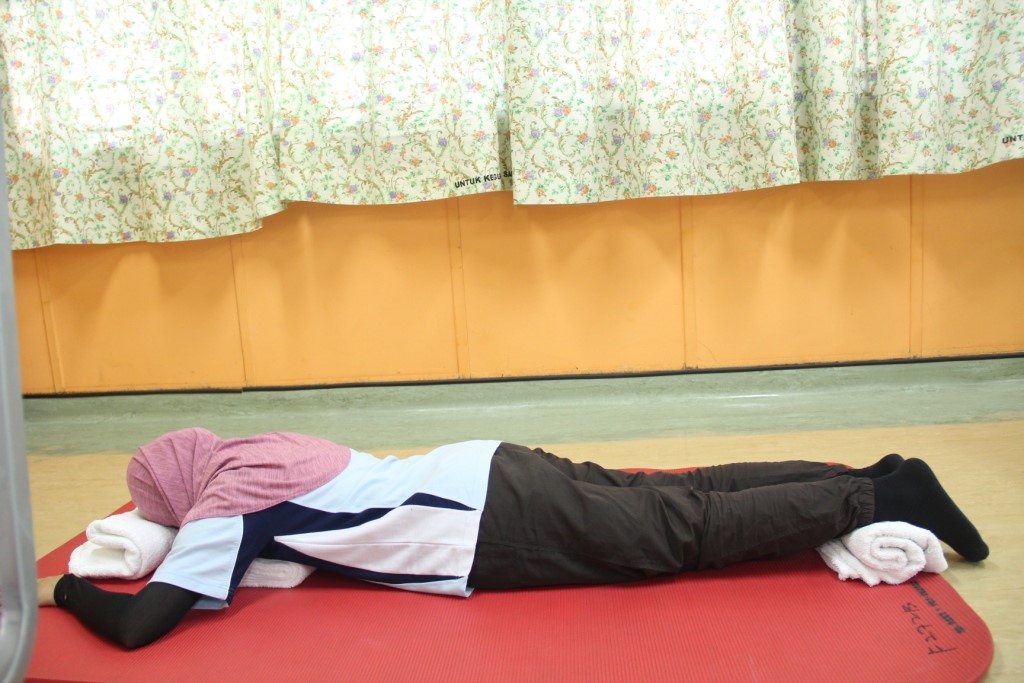 |
 |
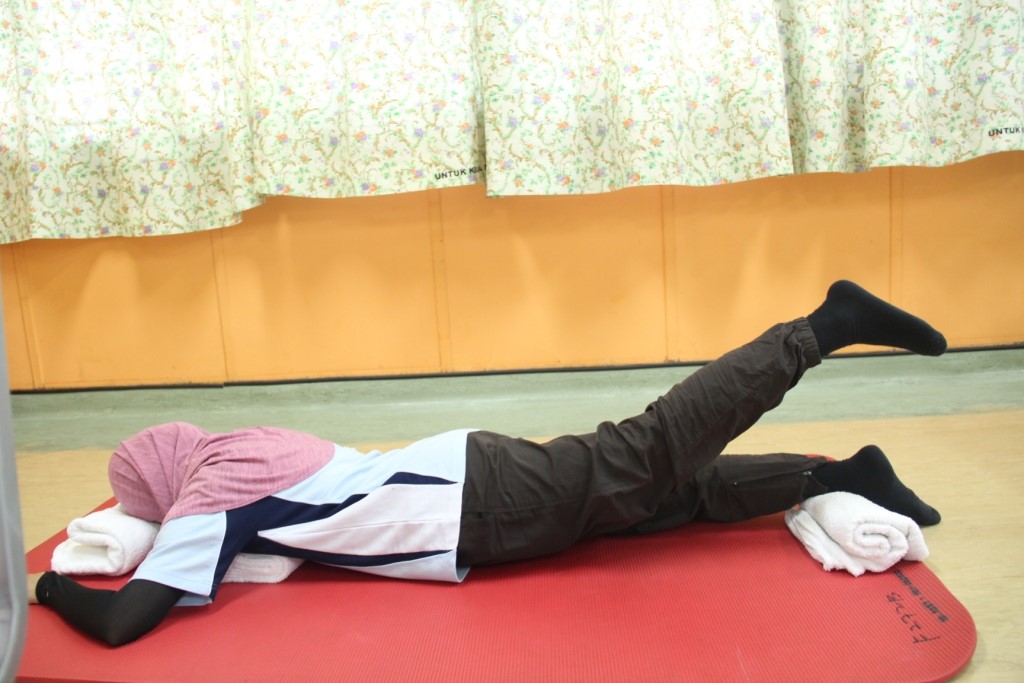 |
| Lie on your abdomen. Place towels under your forehead and shoulders and a towel or pillow under your abdomen for comfort. Bend your right leg slightly and lift your thigh off the floor. Keep your foot relaxed. Lower and repeat 10 times. Then do 10 on the other side. If you can, add an ankle weight that is heavy enough that you cannot lift it more than 10 times. If this causes back pain, try adding another pillow under your abdomen. |
Exercise Programme For People With Osteoporosis
Aerobic activity DAILY:
Walking briskly 30-60 minutes. You may need to build up to this, starting with just 10 minutes per day. If necessary you can split this into portions, and add up to 30+ minutes over the course of each day.
Strengthening Exercises
- Do strength exercises for all of your major muscle groups at least twice, preferably three times, per week. Don’t do strength exercises of the same muscle group on any 2 days in a row.
- Depending on your condition, you might need to start out using as little as 1 or 2 pounds of weight, or no weight at all. The tissues that bind the structures of your body together need to adapt to strength exercises.
- Use a minimum of weight the first week, then gradually build up the weight. Starting out with weights that are too heavy can cause injuries.
- At the same time, remember that you have to gradually add a challenging amount of weight in order to benefit from strength exercises. If you don’t challenge your muscles, you won’t benefit from strength exercises.
- When doing a strength exercise, do 8 to 15 repetitions in a row. Wait a minute, then do another set of 8 to 15 repetitions in a row of the same exercise.
- Take 3 seconds to lift or push a weight into place; hold the position for 1 second, and take another 3 seconds to lower the weight. Don’t let the weight drop; lowering it slowly is very important.
- Gradually increasing the amount of weight you use is crucial for building strength.
- When you are able to lift a weight between 8 to 15 times, you can increase the amount of weight you use at your next session.
If you have Osteoporosis do NOT do exercises which require you to bend forward at the waist. Spontaneous crush fractures of the spine can occur when coming back up from this position. Examples of exercises to avoid: Toe touching and bending the back.
References
- Sinaki M 2003 Critical appraisal of physical rehabilitation measures after osteoporotic vertebral fracture. Osteoporos Int 14:774–779.
- Sinaki M, Itoi E, Wahner HW, Wollan P, Gelzcer R, Mullan BP,Collins DA, Hodgson SF 2002 Stronger back muscles reduce the incidence of vertebral fractures: A prospective 10 year follow-up of postmenopausal women. Bone 30:836–841
- Etherington J, Harris PA, Nandra D, et al. The effect of weight-bearing exercise on bone mineral density: a study of female ex-elite athletes and the general population. J Bone Miner Res 1996;11:1333–8.
- Institute for Clinical Systems Improvement (ICSI). Diagnosis and treatment of osteoporosis. Bloomington (MN): Institute for Clinical Systems Improvement (ICSI); 2008 Sep.
- NIH Consensus Development Panel on Osteoporosis Prevention, Diagnosis, and Therapy. Osteoporosis prevention, diagnosis, and therapy. JAMA 2001;285:785-95.
- http:// http://nof.org/articles/543. Retrieved 1 November 2015.
- www.chap.uk.com/pdfs/EXERCISES%20FOR%20OSTEOPOROSIS.pdf. Retrieved 30 Oktober 2015
Source image
- www.medicinenet.com/. Retrieved 3 November 2015
- Jabatan Fisioterapi, Hospital Kuala Lumpur
- Perkhidmatan Fisioterapi, Bahagian Sains Kesihatan Bersekutu.
| Last Reviewed | : | 23 August 2019 |
| Writer / Translator | : | Ismawi bin Ismail |
| Accreditor | : | Daaljit Singh a/l Harbachan Singh |
| Reviewer | : | Halimah bt. Hashim |







